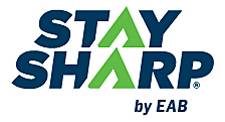
 What happens to your carbide saw blades when they get dull or lose a tooth? Maybe you find a blade sharpening service and send it off for repair, then wait a couple of weeks for your blade to be returned. In the meantime, your saw might sit idle. Or, possibly you don’t go to the trouble and toss the old blade in the trash instead. But where does that spent blade go from there? Chances are pretty good that it’s headed to the landfill, where it will sit for a very long time.
What happens to your carbide saw blades when they get dull or lose a tooth? Maybe you find a blade sharpening service and send it off for repair, then wait a couple of weeks for your blade to be returned. In the meantime, your saw might sit idle. Or, possibly you don’t go to the trouble and toss the old blade in the trash instead. But where does that spent blade go from there? Chances are pretty good that it’s headed to the landfill, where it will sit for a very long time.
You can recycle old tool batteries, turn sawdust into yard mulch and tear a project apart to use the lumber for something else, but saw blades, router and drill bits are a different story. Generally, unless you get them 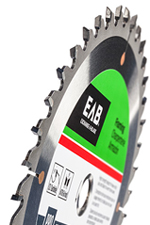 resharpened, they become waste. But there is a “greener” solution, and EAB Tool Company (formerly called Exchange-A-Blade) has been offering it to woodworkers, DIYers, contractors and industrial customers for nearly 40 years. The concept is simple: buy an EAB-branded carbide-tooth blade, and use it. When it dulls or gets damaged, bring it back to the dealer for a no-questions-asked exchange, and save up to 65% over the original purchase price on your next EAB blade purchase. Then, every time you need a comparable blade, bring your old one back, take a fresh one home for the reduced price, and keep on saving money. The company takes these used blades, re-manufactures them if possible or recycles the steel when they can’t be refurbished, and keeps blade waste out of landfills. They pass the savings and the ecological peace of mind on to you.
resharpened, they become waste. But there is a “greener” solution, and EAB Tool Company (formerly called Exchange-A-Blade) has been offering it to woodworkers, DIYers, contractors and industrial customers for nearly 40 years. The concept is simple: buy an EAB-branded carbide-tooth blade, and use it. When it dulls or gets damaged, bring it back to the dealer for a no-questions-asked exchange, and save up to 65% over the original purchase price on your next EAB blade purchase. Then, every time you need a comparable blade, bring your old one back, take a fresh one home for the reduced price, and keep on saving money. The company takes these used blades, re-manufactures them if possible or recycles the steel when they can’t be refurbished, and keeps blade waste out of landfills. They pass the savings and the ecological peace of mind on to you.
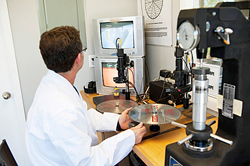 “Last year,” says EAB’s marketing manager Eric Wilson, “we recycled 63 tons of steel consisting of blades and other products … To date, we’re still the only power tool accessories company that even seems to be talking about (sustainability) in this area, let alone doing something about it.”
“Last year,” says EAB’s marketing manager Eric Wilson, “we recycled 63 tons of steel consisting of blades and other products … To date, we’re still the only power tool accessories company that even seems to be talking about (sustainability) in this area, let alone doing something about it.”
It all started when company founder Rob Forbes learned of a sharpening business in Washington that used an exchange model with its customers. Instead of waiting for their exact blade to be resharpened and returned, contractors would take a freshly sharpened, similar blade with them immediately when they dropped their worn blade off. Forbes couldn’t understand why more blade sharpeners didn’t do the same thing. So, he bought a pickup truck and started his own sharpening business.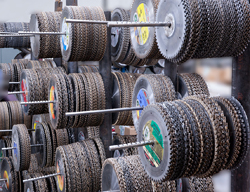
Back in 1976, he offered 30 options of steel saw blades which he took from one hardware store dealer to the next to exchange for used blades. He headquartered the business in the Vancouver area of British Columbia. “By 1983, Exchange-A-Blade was established with dealerships across Canada,” Wilson says.
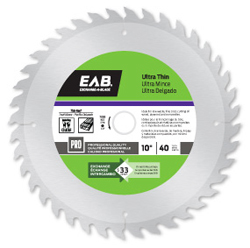 Today, the recently renamed EAB Tool Company continues its operations just outside of Vancouver, in a 35,000-square-foot manufacturing facility with 85 employees.
Today, the recently renamed EAB Tool Company continues its operations just outside of Vancouver, in a 35,000-square-foot manufacturing facility with 85 employees.
While the majority of its blade and bit sales are to Canadian customers, the company continues to expand its operations into the western United States, with pockets more eastward. There are EAB dealerships in Washington, Oregon, California, Montana, Idaho, Utah, Arizona, New Mexico, Michigan and New York.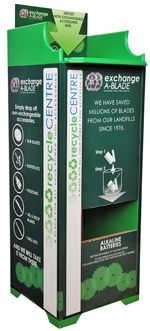
Over the past 38 years, EAB’s product offerings have grown substantially, too. The company currently offers 125 different carbide saw blades, 130 options of diamond saw blades, 65 SKUs of oscillating tool accessories, 115 router bit variations, abrasives, hole saws, jigsaw and recip saw blades, drill and SDS bits, plus screwdriver and impact bits. Most of these product families are divided into the three categories of general quality (light professional and DIY use), professional quality and industrial quality.
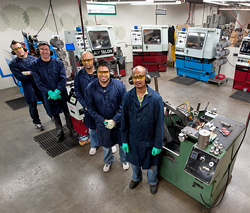 “We carry a very extensive selection in each product category, numbering hundreds of SKUs in all the popular sizes and profiles, and most of the oddball ones as well.” Wilson says the sheer variety has been a key differentiator for EAB between it and other leading brands of blades and bits. “Whereas they blanket the market with high-volume products, we also provide hard-to-find specialty products.”
“We carry a very extensive selection in each product category, numbering hundreds of SKUs in all the popular sizes and profiles, and most of the oddball ones as well.” Wilson says the sheer variety has been a key differentiator for EAB between it and other leading brands of blades and bits. “Whereas they blanket the market with high-volume products, we also provide hard-to-find specialty products.”
EAB only remanufactures its carbide saw blades, not competitors’ blades, in order to maintain the highest level of quality. Still, the company will accept any brand of used blade as a convenience and will recycle the steel at no charge to the customer. For a time, EAB also remanufactured its router bits, but Wilson says the complex geometry of router bit design made remanufacturing difficult. “We couldn’t achieve our ‘good as new goal,’ so it was discontinued.”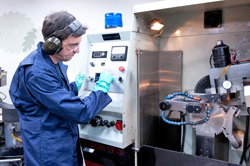
Other products, like screwdriver and drill bits either can’t be remanufactured practically, or the process for doing so is economically unfeasible. Those sorts of non-exchangeable items constitute EAB’s “StaySharp” brand.
When an EAB blade is returned to a dealer for exchange, the remanufacturing process is quite extensive. And the ultimate goal is to get the product reconditioned “to be as good as, and in most cases better than, a new blade.” Each blade first gets a thorough inspection in EAB’s remanufacturing plant to see if it is viable for retooling (store dealers do not make these determinations). It’s sorted, cleaned and then carefully checked for plate cracking, warping and other defects. Any missing teeth are replaced with the same grade of carbide, then all four faces of 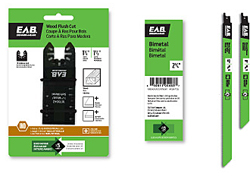 every tooth are resharpened to original specs. A final cleaning and polishing follows that, rust inhibitor is applied, and the blade receives a new label. An in-house laboratory pulls random reconditioned blades for quality control testing.
every tooth are resharpened to original specs. A final cleaning and polishing follows that, rust inhibitor is applied, and the blade receives a new label. An in-house laboratory pulls random reconditioned blades for quality control testing.
In the end, Wilson says, this attention to detail means that customers taking a fresh blade home should see absolutely no difference between the blade being new or remanufactured.
Wilson says the company’s “green” approach to product manufacturing doesn’t stop there. EAB also keeps packaging to a minimum, in order to minimize added waste. What is used for packaging contains recyclable, post-consumer content. 
And, blades are not chromium-plated, as is the case with some other brands, because of the negative environmental impact of its byproducts.
It’s interesting to learn that EAB sees a 90 percent return rate on its industrial quality blades. Depending on the blade type and region, that percentage drops some for its professional blades and more still for the general quality category. But, Wilson points out, in some areas the return rate on general quality blades “can still can be as high as 20 to 30 percent.”
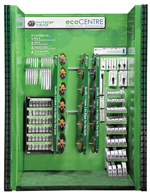 EAB’s success over the years is due, in part, to the fact that Forbes’s objectives back in 1976 haven’t really changed that much today. According to Wilson, customers continue to get a high quality product at a competitive or significantly lower price, so the value proposition is high. There’s convenience, too, because blade users don’t have to wait for their blade to be resharpened; they take a fresh blade back to work immediately. And, EAB’s sales team visits each dealer store on a regular basis in order to maintain direct relationships with store managers and customers. “Even today in the era of massive distribution networks, EAB has stuck to this model, and it continues to work.”
EAB’s success over the years is due, in part, to the fact that Forbes’s objectives back in 1976 haven’t really changed that much today. According to Wilson, customers continue to get a high quality product at a competitive or significantly lower price, so the value proposition is high. There’s convenience, too, because blade users don’t have to wait for their blade to be resharpened; they take a fresh blade back to work immediately. And, EAB’s sales team visits each dealer store on a regular basis in order to maintain direct relationships with store managers and customers. “Even today in the era of massive distribution networks, EAB has stuck to this model, and it continues to work.”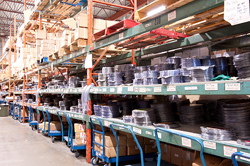
But, Wilson says, there’s also the intrinsic value of “reusing and recycling” that goes along with investing in EAB-brand blades, and that’s part of what feels good about being a pioneering company in this segment of the tool industry.
It’s blade consumption we can all have reason to feel good about.
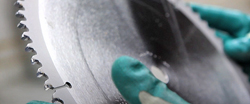 “We all know there is tremendous waste in our society, and the only way we’re going to reduce that is if everyone chips in. EAB makes it pretty easy for builders, contractors and woodworkers to do that — and still get a great product at a fair price.”
“We all know there is tremendous waste in our society, and the only way we’re going to reduce that is if everyone chips in. EAB makes it pretty easy for builders, contractors and woodworkers to do that — and still get a great product at a fair price.”
To learn more about EAB Tool Company and its products, click here.





